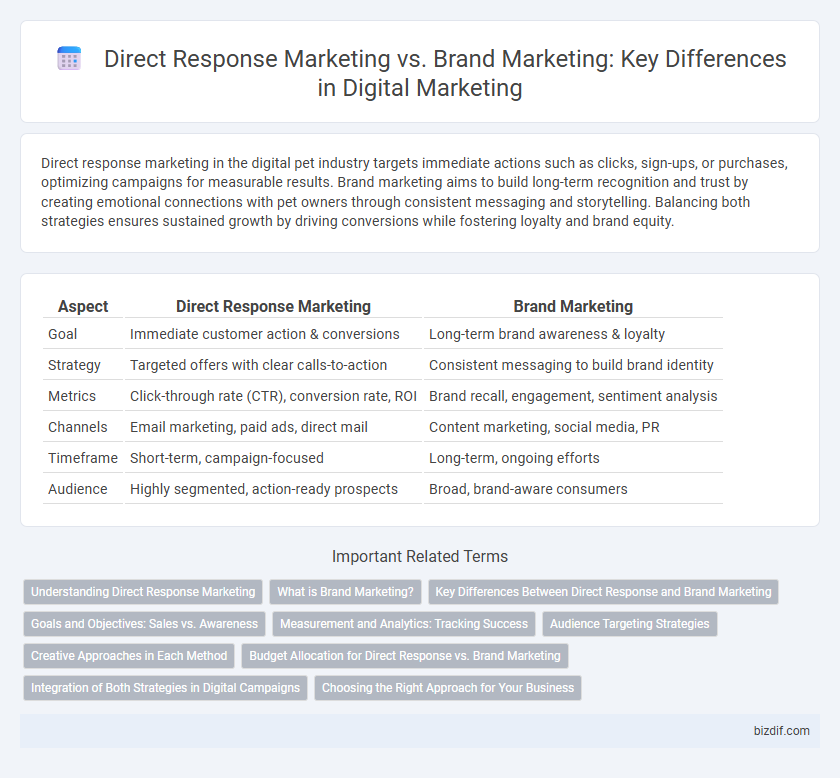Direct response marketing in the digital pet industry targets immediate actions such as clicks, sign-ups, or purchases, optimizing campaigns for measurable results. Brand marketing aims to build long-term recognition and trust by creating emotional connections with pet owners through consistent messaging and storytelling. Balancing both strategies ensures sustained growth by driving conversions while fostering loyalty and brand equity.
Table of Comparison
| Aspect | Direct Response Marketing | Brand Marketing |
|---|---|---|
| Goal | Immediate customer action & conversions | Long-term brand awareness & loyalty |
| Strategy | Targeted offers with clear calls-to-action | Consistent messaging to build brand identity |
| Metrics | Click-through rate (CTR), conversion rate, ROI | Brand recall, engagement, sentiment analysis |
| Channels | Email marketing, paid ads, direct mail | Content marketing, social media, PR |
| Timeframe | Short-term, campaign-focused | Long-term, ongoing efforts |
| Audience | Highly segmented, action-ready prospects | Broad, brand-aware consumers |
Understanding Direct Response Marketing
Direct response marketing drives immediate customer actions through targeted calls-to-action, measurable results, and personalized messaging, making it highly effective for lead generation and sales conversion. Unlike brand marketing, which builds long-term brand awareness and equity, direct response marketing uses channels like email campaigns, pay-per-click ads, and direct mail to elicit quick responses. Marketers prioritize tracking response rates, cost per acquisition, and customer lifetime value to optimize campaigns in real time.
What is Brand Marketing?
Brand marketing focuses on building long-term awareness and emotional connections between a company and its target audience through consistent messaging and visual identity. It emphasizes creating a recognizable brand image and reputation that fosters customer loyalty and trust over time. Key elements include storytelling, brand values, and engagement strategies designed to enhance brand equity and differentiate from competitors.
Key Differences Between Direct Response and Brand Marketing
Direct response marketing focuses on immediate, measurable actions such as clicks, leads, or sales, utilizing targeted campaigns with clear calls to action to drive conversions and optimize ROI. Brand marketing aims to build long-term brand awareness, loyalty, and perception through consistent messaging and emotional connections, often measured by metrics like brand recall and customer engagement. Key differences include the time horizon for results, measurement methods, and campaign goals--direct response targets short-term performance, while brand marketing emphasizes sustained brand equity growth.
Goals and Objectives: Sales vs. Awareness
Direct response marketing targets immediate sales through measurable actions like clicks and conversions, driving short-term revenue growth. Brand marketing focuses on building long-term awareness, customer loyalty, and emotional connections, which enhance market positioning over time. While direct response campaigns prioritize ROI through specific calls-to-action, brand marketing aims to increase recognition and preference without requiring instant purchase decisions.
Measurement and Analytics: Tracking Success
Direct response marketing relies heavily on precise measurement and analytics, tracking metrics such as click-through rates, conversion rates, and return on ad spend (ROAS) to evaluate immediate campaign success. Brand marketing measurement focuses on long-term indicators like brand awareness, customer engagement, and brand sentiment analysis through surveys and social listening tools. Effective digital marketing strategies integrate both approaches, using advanced analytics platforms to attribute results accurately and optimize budget allocation between direct response and brand-building efforts.
Audience Targeting Strategies
Direct response marketing employs precise audience targeting using data-driven tools like retargeting, behavioral analytics, and personalized offers to elicit immediate actions. Brand marketing focuses on broader audience segments using demographic, psychographic, and cultural insights to build long-term loyalty and emotional connection. Combining granular targeting for conversion with expansive strategies for brand equity maximizes overall campaign effectiveness.
Creative Approaches in Each Method
Direct response marketing emphasizes attention-grabbing creatives with clear calls-to-action designed to generate immediate customer engagement and measurable outcomes. Brand marketing leverages storytelling, visual identity, and emotional resonance to build long-term recognition and loyalty across multiple touchpoints. Each approach tailors visual and messaging strategies to either prompt instant response or cultivate sustained brand affinity.
Budget Allocation for Direct Response vs. Brand Marketing
Budget allocation for direct response marketing typically emphasizes measurable, short-term ROI with investments often ranging from 60% to 80% of the total marketing budget, targeting immediate lead generation and conversions. Brand marketing budgets tend to focus on long-term equity building, usually comprising 20% to 40% of the budget, aimed at enhancing brand awareness and customer loyalty over time. Balancing these allocations depends on business goals, with direct response delivering quick results and brand marketing fostering sustained market presence.
Integration of Both Strategies in Digital Campaigns
Integrating direct response marketing and brand marketing in digital campaigns maximizes customer engagement by combining immediate action prompts with long-term brand value building. Data-driven personalization enhances direct response tactics, while consistent brand messaging across channels strengthens brand recognition and trust. This holistic approach leverages performance metrics and emotional resonance to drive both conversions and customer loyalty effectively.
Choosing the Right Approach for Your Business
Direct response marketing drives immediate consumer action through measurable tactics such as email campaigns, pay-per-click ads, and limited-time offers, making it ideal for businesses seeking quick sales and ROI. Brand marketing focuses on building long-term brand awareness and loyalty through storytelling, consistent messaging, and emotional connections across channels like social media and content marketing. Selecting the right approach depends on your business goals, target audience behavior, and budget allocation, balancing short-term conversions with sustained brand equity growth.
Direct response marketing vs Brand marketing Infographic

 bizdif.com
bizdif.com